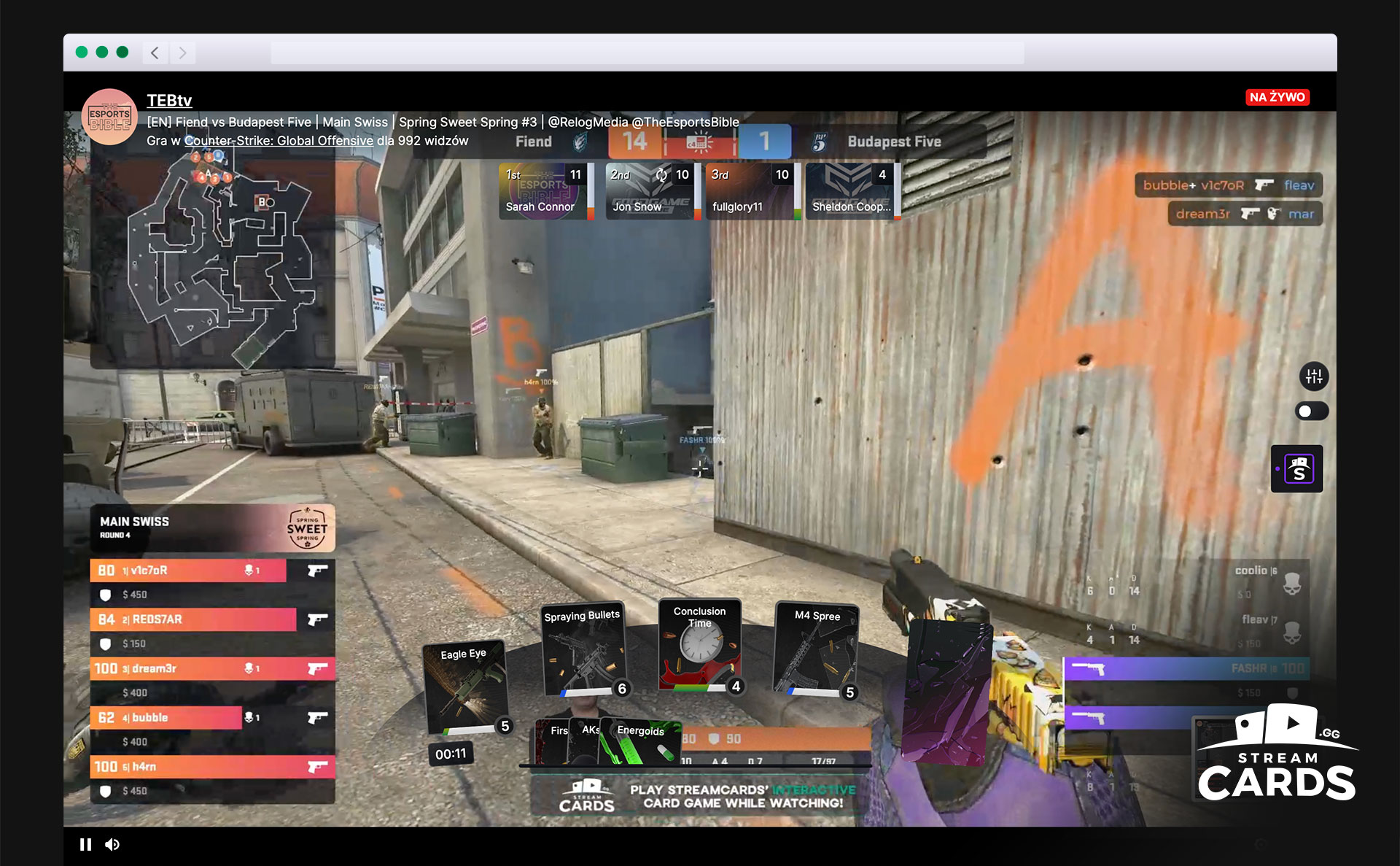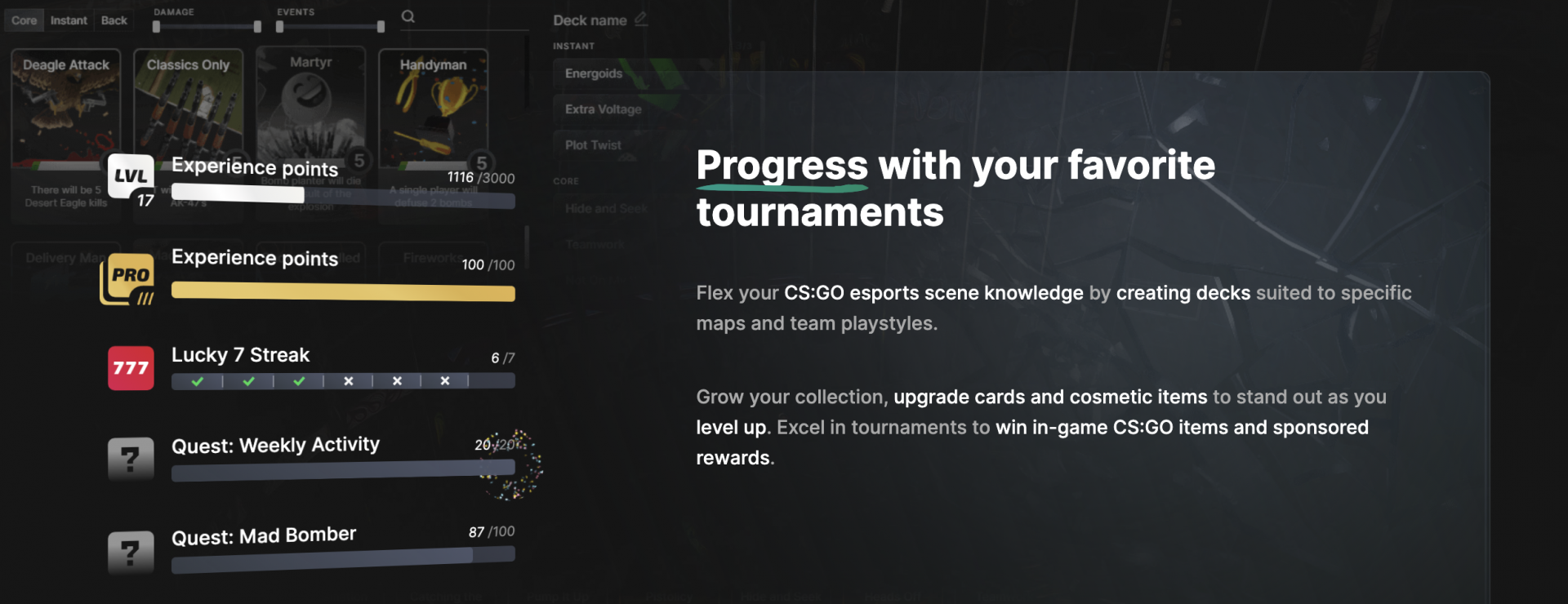Twitch effectively categorised esports in April 2020 when the livestreaming platform introduced an ‘Esports’ specific tab onto its homepage.
On today’s UI, the category rests alongside Gaming, IRL and Music with the subtext: “Live tournaments, match highlights, and your favourite pro players all in one place.”
Gaming is for fun, Twitch seems to specify. Esports is for professionals, or at least, those on a path towards it. Before this categorisation, viewers had to know what they were looking for or be satisfied with what the discoverability algorithm fed them.

RELATED: StreamCards raises $530,000, partners with The Esports Bible for closed beta
The platform debuted ‘extensions’ in August 2017, as explained on Twitch’s Creator Camp page: “You can think of extensions as apps for your streams that give your community more ways to interact with you, each other, or what you’re streaming.”
Like browser extensions, Twitch extensions are generally designed to enhance the experience of the core service. Twitch extensions allow the audience to vote, collect digital items, and interact in other ways with live-streamed content.
Warsaw-based start-up StreamCards has devised a clever way to combine the over-the-top (OTT) functionality of Twitch extensions with in-game player performance data to create a unique gaming experience for esports audiences.
Debuting with CS:GO, the StreamCards extension is integrated into participating broadcasts to let viewers play a card game atop esports matches, gamifying the viewing experience by reacting to live in-game data.
Esports Insider sat down with StreamCards CEO, Daniel Sieradzan, and VP Operations, Dominika Szot to learn more about the game development aspect of designing an experience over esports broadcasts and what the extension can offer both broadcasters and viewers.

Gamifying the viewing experience
Instead of building something in hopes that users would come, the StreamCards team set out to enrich the experience of an underserved existing segment — fans who already watch esports broadcasts.
Shuffling in Sieradzan’s work in the customer loyalty space alongside Szot’s expertise in creating marketing and advertising automation solutions, the team took a few stabs at OTT solutions that would excite and engage viewers before drawing the real-time card game format from their deck of ideas.
British-born Sieradzan told Esports Insider that at first they toyed around with a quiz extension, however, the feeling was that quizzes felt disposable and often trivial.
“While quizzes could add an element of interactivity,” he said, “they offered limited value for the viewer. It simply didn’t feel epic enough, with limited consequences behind viewer’s decisions.”
According to Szot, existing esports broadcast Twitch extensions only provided ‘nice to have’ features, like interactive statistics or brackets.
“It’s quite surprising how little has been done with the fact that the core nature of esports and gaming is interactivity.”
It had to be more like a game, no, it had to be a game. A game on top of watching pros play a game. Not your typical Twitch meta.
StreamCards’s first version was one-versus-one, but the team wanted to push the mechanics to be more community-oriented to address the asymmetric experience of a community watching a broadcast.

RELATED: Esports Insider announces return of ESI Digital Summer and The Clutch
“We wanted to give that sense of interaction to as many people as possible,” Sieradzan said.
“As time went on, we realised there’s so much more that an on-stream card game can offer both broadcasters and viewers,” he continued. “Aside from building the world’s first gamification overlay, we are also creating the world’s first esports viewership loyalty programme.”
With StreamCards, viewers can earn rewards not only within the product’s digital economy, but also within a sponsor’s ecosystem. Which opens up the possibility of partnerships with skins marketplaces or even non-endemic brands.
Ranking among the top players for a given broadcast series means top-performers can win rewards such as CS:GO skins, as redeemed through a skins marketplace platform.
“We have opened talks with several of them (sponsors),” Sieradzan said, “this makes sense for the whole ecosystem, as we can incentivise viewers to visit a site to redeem their reward.
“We can help with user acquisition and activation in completely new ways.”
The start-up debuted a closed-beta version in May, in partnership with The Esports Bible. Thanks to a mutual partnership with GRID Esports, viewers of the Spring Sweet Spring CS:GO Tournament could play cards on top of the tournament’s Twitch broadcast, trying to predict micro-events that would happen in each game.

StreamCards game engine has been designed to recognise ‘micro-events’, which are described as specific in-game moments. Participants can join a game of StreamCards at any point during the tournament. Knowledge of the map and current game state inform viewers to draft more appropriate cards into their deck.
Once in a game, viewers select cards they predict will have the highest likelihood of having their conditions satisfied. For example, the ‘Vault’ card reads that the selected team player will spend more than 8,000 during one buy-in. If the condition is satisfied, the player will receive 5 points added to their score.
Effect cards like ‘Death and Taxes’, which state that other players’ payoffs from their next completed card are limited to only 3 points, keep the game competitive and add new layers to the experience.
Knowledge of the game, the maps, the teams, and the meta all comes into play, engaging the viewing experience much deeper than watching a linear broadcast.

Over-the-top development
Working within the constraints of designing a UI that exists on top of a broadcasters product provided unique challenges for the team. “We have to respect a broadcaster’s screen estate,” Sieradzan said, “at the same time making it StreamCards viewer centric.”
As such, the UI appearance might be very different in a few months to its current beta-test state as the company looks to continue to take on feedback.
Szot shared that because the card game format is already well understood by players, cards as the core visual and interactive medium made the most sense. Developing the game’s reward system was also crucial to the attractiveness of the experience, she continued.
StreamCards is a product for super fans with the utmost knowledge of the title and its mechanics and the product had to serve them first, while not intimidating CS:GO newbies. Besides being entertaining, it would also have to be balanced.
The StreamCards team is said to have analysed over 50,000 rounds of CS:GO pro matches, establishing what would constitute to being a micro-event, measuring rates of occurrence, and creating cards out of their findings.
The team looked at the competencies of events, how attractive cards are relative to others, and how much risk players are looking to take on when drafting.
By observing how people behave in the game and how risk-averse they are, the team assigned probabilities behind some of the events to balance the game.
“Players find [StreamCards] even more exciting and engaging than they had expected,” Szot said. “[The feedback shows] people are actually very engaged by what they’re doing and they stay for longer than they expected, or they lose track of time.”

Correctly recalled information about the cards has been impressively high during product feedback rounds, added Szot. “It’s a great indicator of what we can do in the future with that level of attention.”
As StreamCards moves out of closed-beta into open-beta, testing will focus on bigger picture pain points, such as user progression, levelling and unlocking additional cards. The full product is slated to debut around Q3 of this year.
The team predicts that once the core product is dialled in, it can scale radically. Other tactical shooters, MOBAs, and even mobile titles could very well be on the menu, but first the team wants to polish the engagements and incentivisation behind the initial product.
“StreamCards offers broadcasters the possibility to create visually customised cards for their tournament.” Sieradzan said. “This unlocks a sea of possibilities, as we can actually track the number of interactions a card has had via our powerful in-game analytics.
“We offer an interactive medium over traditional on-stream banners. It is up to the broadcaster to decide how they unleash the value of our suite of features.”
[primis_video widget=”5183″]RELATED: Telling better stories with esports data — GRID
The start-up is also currently in talks with global broadcasters, according to Sieradzan.
“Our goal as StreamCards is to create an ecosystem consisting of only a handful of broadcasters per esports title and offer a bespoke experience for their viewers,” he said. “Who will be looking to continue their progression within StreamCards on the next available broadcast.”
With Twitch staking its claim as a home to esports, StreamCards’s future seems to be tied to the broadcasts’ growing viewership on the platform.
So long as there are no messy breakups, the start-up developing its business around a niche extension for an existing segment could very well be in an ocean of opportunity.
All this comes down to understanding what the esports audience wants, and that’s to game. Where there are games, there’s data. Where there’s data, there’s money.
Brands looking to activate into esports will likely take some convincing. However, demonstrating a novel way for the audiences to meaningfully interact with brand touchpoints during sponsored esports broadcasts is just one ace StreamCards has up its sleeve.
[maxbutton id=”18″ ]
